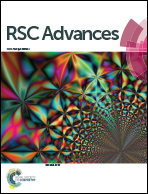1-Dimensional fiber-based field-effect transistors made by low-temperature photochemically activated sol–gel metal-oxide materials for electronic textiles†
Abstract
We report the high performance metal-oxide fiber field-effect transistors (F-FETs) for electronic textiles (e-textiles). By using low-temperature and a solution process, dense, pinhole-free, and relatively uniform metal-oxide layers were successfully deposited on a 1-dimensional fiber substrate. Particularly, the atomic layer deposited aluminum oxide gate dielectric layer, deposited at 100 °C, exhibited an extremely low leakage current density of ∼10−7 A cm−2 and a high breakdown field of 4.1 MV cm−1. Furthermore, the indium oxide F-FETs, which are photochemically activated at a low temperature, showed a field-effect mobility and on/off ratio of 3.7 cm2 V−1 s−1 and >106, respectively, which we believe are the highest performance among fiber-type FETs reported to date. Based on these results, it is believed that the metal-oxide F-FETs may provide a basic building block to accomplish 2-D woven e-textiles in the future, provided further combining with the weaving and interconnection technologies.


 Please wait while we load your content...
Please wait while we load your content...